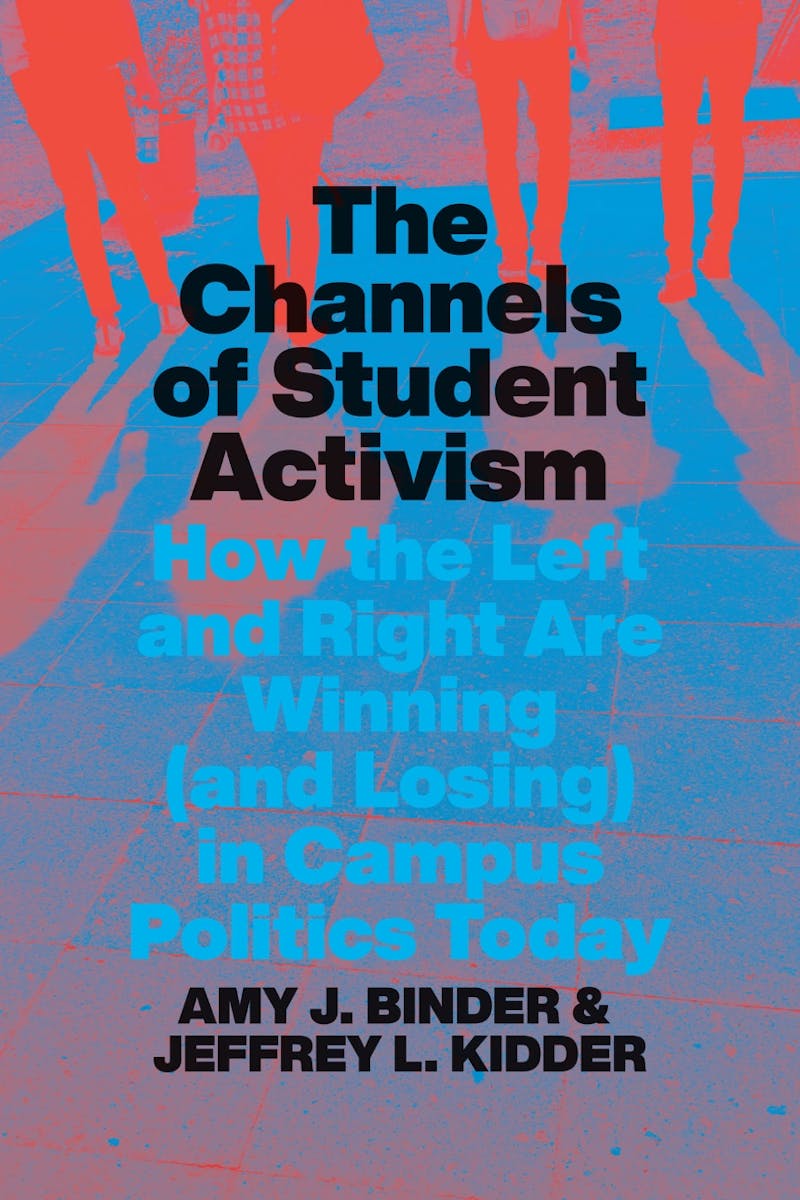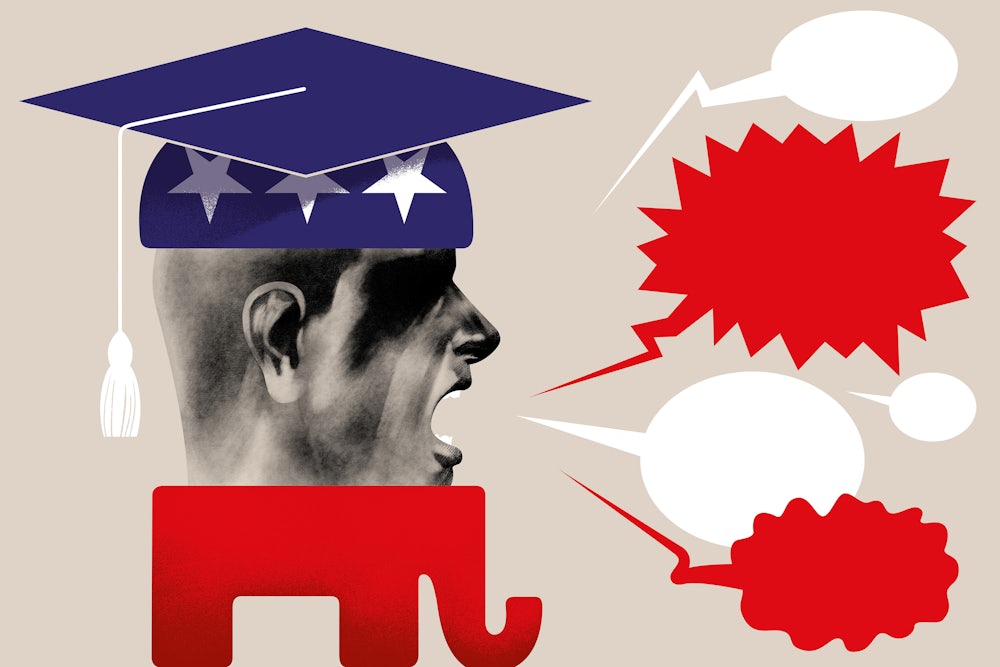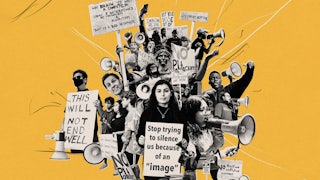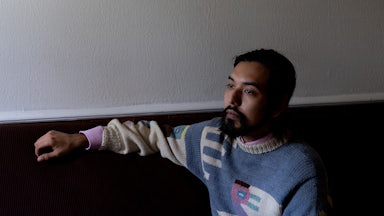Wherever you get your news, whether it is Twitter or The New York Times, you might reasonably imagine that higher education is awash in political conflict. You might see with dismay that progressive students are intolerant, hysterical, and fragile; or, depending on your sources, that right-wing students platform the vilest, most bigoted media personalities in the name of free speech. In these seemingly dystopian (and, as it turns out, semi-fictional) scenarios, coddled Gen Z’ers, backed by Diversity, Equity, and Inclusion officers, respond to provocation by silencing conservative peers and dis-regarding academic freedom and free speech norms. Students across the ideological spectrum denounce faculty over political disagreements. And if liberal campus activists agitate nonstop for safe spaces and for trigger warnings on course materials, conservative kids claim they are not permitted to speak at all.
As you read these stories, you might ask: Where are the adults? The same outlets will tell you. When faculty aren’t on a picket line or forcing students to self-censor to get a good grade, tenured radicals (as Roger Kimball famously called us in 1990) eliminate traditional, fact-based humanities and social sciences course content in favor of critical theory that stigmatizes men, white Americans, heterosexuals, and people who identify with the gender binary. In the right-wing imagination, university administrators spend their days accusing local businesses of racism (see: the Oberlin bakery fiasco of 2016) and silencing campus conservatives.

High-profile conflicts over free speech and academic freedom are not exactly invented—but the larger narrative I just sketched is false. As Pennsylvania State University communications professor Bradford Vivian argues in Campus Misinformation: The Real Threat to Free Speech in American Higher Education, violations of decorum are comparatively rare, but the right has woven them into a dangerous meta-narrative about the fragility of First Amendment freedoms on campus. And the strategy has worked. Liberals and liberal media institutions are often so unsettled, and perhaps embarrassed, by events that position left-wing students as intolerant and illiberal that they have come to believe in a manufactured crisis.

As anyone who works in higher education knows, however, the thousands of classes, events, extracurriculars, and dorm conversations that make up most of daily life on a university campus normally occur without incident, whether students agree or disagree with one another. In their book The Channels of Student Activism: How the Left and Right Are Winning (and Losing) in Campus Politics Today, sociologists Amy J. Binder and Jeffrey L. Kidder recognize this reality and ask how students actually experience the campus culture wars fueling our nation’s partisan divide. Their findings suggest that students across the political spectrum are generally more tolerant, more interested in diverse viewpoints and ideas, and more critical of their own political allies than assumptions about political polarization can account for.
But what both books show is that the right is better positioned to take advantage of the scandals—some provoked and others resulting from poor decisions—that do erupt. National student organizations are better at channeling students with conservative leanings into professional activism aimed at creating bad press for higher education. Right-wing media is so effective at seizing on and amplifying controversies, making sure that the distortions that proliferate on social media become the focus of higher education coverage, that mainstream news organizations are often just covering the coverage rather than investigating events. The networks that sustain the campus culture wars are not only powerful and well-financed; they operate far beyond campus.
Campuses have always been targets for political attacks, and students, as Binder and Kidder contend, have always acted to assert “their vision of what American democracy should look like.” In 1775, one student, a young Alexander Hamilton, held at bay a howling mob that was bent on violently seizing and expelling the Loyalist Tory president of King’s College in Manhattan (now Columbia University). Hamilton’s spellbinding revolutionary oratory allowed the frightened administrator to slip away and make his way to an English ship.
Although the classical educations favored by gentlemen and aspiring gentlemen prior to the late nineteenth century left little room for arguments about current affairs, it was still difficult to guard campuses from a disputatious, and often violent, American political culture. Between 1760 and 1860, students rioted repeatedly for their right to dissent from rules that they believed were unjust. Princeton, which prided itself on campus comity between Northern and Southern men in these years, kept the peace by banning political displays on campus. When war broke out in 1861, that agreement crumbled: Northern students took over the university’s oldest building and hung the Union flag from it.
But political disputes did not harden into arguments over speech and academic freedom until the twentieth century. We can trace the rise of campuses as sites for conservative cultural anxiety to the publication of William F. Buckley Jr.’s God and Man at Yale: The Superstitions of “Academic Freedom” (1951). As Buckley charged, colleges had become not just dangerously progressive, but secular. Yale’s curriculum, he argued, had reduced religion to an intellectual course of study that served few students. Courses were taught by nonbelievers, at least one of whom regarded faith as a “useful superstition.” The criticisms stung, particularly because Buckley’s book became a national bestseller. In February 1952, both in the wake of the book and amid Wisconsin Senator Joseph McCarthy’s attacks on educators, a committee of Yale alumni responded with an investigation into communism, irreligion, and academic freedom at the institution.
The charges, the committee concluded, were baseless. Yale had “no Communist on the faculty at the present time,” and knew of no faculty who were “trying to undermine or destroy our society” or propagate “subversive theories.” It discovered no instances of “intimidation” and found religious life “stronger than most places outside.” Yale’s business was “to educate, not to indoctrinate.” Every student was “entitled to a fair presentation” of all knowledge, “so as to be able freely to make up his own mind. That is Yale’s policy.”
Today’s academic culture wars are not so different from Buckley’s attack on Yale and Yale’s rebuttal, except in their ubiquity and intensity. Conservative critics now argue that liberal political indoctrination in education is a potent national security threat; that traditional religious values create a platform for a moral and truthful education; and that the free speech of conservatives is persistently threatened by liberal and left-wing groupthink. And liberals are consistently on the defensive.
What Binder and Kidder learned in their research, however, is more complicated than what I just described. Yes, scandalous events that make national news reflect real political divisions on campus, and conservative students may well be anxious about being stigmatized for their views. A survey of freshmen at 147 U.S. colleges and universities, conducted by UCLA’s Higher Education Research Institute in 2018, found that conservative students used their right to free speech less than other students. If two-thirds of leftist students and over half of liberal students claimed to have engaged in a form of public, political speech, only 41 percent of conservative and moderate students did.
And yet it is unclear why this is so, or whether this number reflects a problem educators ought to be concerned about. In 2022, Emma Camp, a student at the University of Virginia (one of the four cam-puses where Binder and Kidder did their research), wrote an op-ed in The New York Times about students of all political persuasions who consistently refrained “from saying what we really think.” Students feared the ostracism of their peers and even “lower grades if they don’t censor themselves.” But this may not be a liberal-conservative issue at all: Binder and Kidder found that left-wing students frequently disparaged liberalism.
There are also many institutions where conservatives can hardly claim to be on the back foot. For example, at Hillsdale College, a conservative, Christian school in Michigan, students study the classics, in “a supportive community dedicated to the highest things.” Notably, the curriculum’s focus on the archaic deliberately evades forms of intellectual conflict and modern critical theory that many conservatives find distasteful. Students who choose a curriculum that skirts thorny discussions about race, gender, sexuality, or contemporary social issues have also chosen an intellectual environment that is as cocooned—if not more so—as any right-wing caricature of an African American studies or feminist theory class at a more liberal university.
Conservative students who chose instead to attend liberal institutions, however, were often happy to encounter opposing views. While some told Binder and Kidder that college hadn’t changed their outlook at all, others found that being challenged shifted their political positions. Some had come to prefer a populist conservatism over a traditional, corporate Republicanism, while others grappled with complexity and contradiction. “I feel like I’m more empathetic and more understanding of other people’s viewpoints,” one student said, explaining that classes with professors from the Middle East had caused her to rethink the right’s animus toward Muslims. College did what it was supposed to do: It made students think and prepared them to live in a world where disagreement must be navigated.
Unsurprisingly, across political lines, students are not being indoctrinated: They make choices and, as Binder and Kidder put it, sort themselves across the different opportunities a campus offers. They have genuine interests that are supported by clubs and outside groups that offer real-world organizing experience (and résumé lines). But while these forces do not compel ideological conformity, they do play a role in “channeling” a subset of students into political identities and, to all intents and purposes, shaping them into professional activists.
As it turns out, however, conservatives are much better than liberals at recruiting and training students. Conservatives have “managed to build an elaborate, well-funded organizational space,” Binder and Kidder write, “that galvanizes young supporters and grooms future leaders by pulling them outside the confines of campus” and into paid work that sets them up for postgraduation careers as movement conservatives.
These organizations also owe something to Buckley, who in 1960 created a group to spur young conservatives to action. Young Americans for Freedom (YAF) trained conservative students as organizers and networked them with their adult counterparts, much as Turning Point USA (TPUSA) or the now-regional meetings of the Conservative Political Action Conference (CPAC) do today.
Current campus groups, well-lubricated with outside money, are a function of YAF’s early success and now constitute, as Binder and Kidder note, “a powerful external ecosystem” that trains and pays right-wing students to organize. National 501(c)(3) groups like TPUSA, PragerU, and CampusReform.org employ students to be soldiers in a social-media war against the “libs” and to protest campus diversity initiatives. Other groups, like the Goldwater Institute, Young Republican National Federation, the American Enterprise Institute, and the Heritage Foundation’s Young Leaders Program, offer activism training, networking, and clear paths to political and policy careers.
Right-wing campus organizations do not just voice the concerns of their members. By goading progressive students, they deliberately incite conflict to create newsworthy events, stoking false narratives about liberal and left threats to free speech more generally. A frequent tactic is to invite controversial speakers to campus in order to provoke “liberal tears,” or elicit emotional, attention-grabbing responses that can then be circulated on the internet. Protests at Milo Yiannopoulos’s scheduled speech at the University of California, Berkeley, in 2017 spun out of control and became violent; but they were intended to stoke the anger of liberal and left students in the first place and provide visual evidence that “the left” are censors and bigots supported by activist administrators.
As Vivian argues, this strategy undercuts conservatives’ insistence that “viewpoint diversity,” or equal representation of conservative thought on campus, is their actual goal. The fact is that an event that must be shut down because the speaker cannot be heard, or because campus police cannot control an aggressive crowd of protesters, is far more useful to a national conservative organization than one that is peaceful, courteous, and civil. An almost infinite number of utterances, lectures, talks, performances, and casual exchanges occur on campuses across the United States every day without a single feather, left or right, being ruffled; we don’t hear about them.
Above all, conservative student organizations are currently outgunning liberal and left campus activism because conservatives are playing a long game that treats youth as junior partners in a larger political enterprise. They pay students more and invest heavily in campus culture wars as part of the larger battle to push the nation to the right. As Vivian notes, attacks on universities are part of a comprehensive set of “anti-education tactics” that tend to emerge “in periods of rising authoritarian sentiment.”
Perhaps most significantly, “well-funded national organizations” have established clear and lucrative career paths for the campus conservatives they recruit. After graduation, conservative student activists can expect to move along to the Heritage Foundation or work in conservative media, Congress, and Washington Beltway political consulting. Well-funded campus jobs propel right-wing students from Campus Watch, TPUSA, and the campus youth publication Lone Conservative to the Washington Examiner, Breitbart, Real Clear Politics, and Project Veritas. The right’s investment in media is not just about manufacturing misinformation about liberal elites and trolling ideological enemies: It’s a pipeline to the larger misinformation world that influences elections. Students who pay their dues on campus may find themselves siphoned upward into a media organization, and from there to political consulting, congressional staffing, and running Super PACs.
Of course, progressive organizations recruit students, too, but not on this scale, and without the major events—like CPAC, where student activists go to résumé and interviewing workshops—that might help young liberal and left activists map a career. Despite the perception of college campuses as bastions of liberal intolerance, progressive students are also more identified with, and crucial actors in, campus diversity initiatives that buttress the reputation of institutions as tolerant and concerned with social justice. “Students on the left take classes with professors who produce frameworks for understanding social inequities” and negotiate with administrators to implement reforms, Binder and Kidder write. By airing grievances and staffing key student leadership positions, these activists come to embody the diversity initiatives that have shaped the higher education project more generally since the 1960s.
Yet the left lacks the support structures for activist students that the right has engineered over several decades. Whereas conservatives benefit from robust financing and tight networks, liberal, left, and moderate students seem to reflect the contentious and poorly coordinated nature of progressive networks and the fractured quality of left politics on and off campus. Binder and Kidder found that, as is often true in the Democratic Party, liberals and leftists were far less able than conservatives to agree on tactics or support one another in disagreement. Confrontational left tactics pushed one student whom Binder and Kidder interviewed to pay closer attention to conservative students’ right to free speech, and to put “distance between himself and what he felt was the radical fringe.”
Progressive students’ political work is also less well-paid and does not offer “a clear path with identifiable steps for converting their activism into an occupation.” The so-called liberal media, whether corporate or nonprofit, does not have a pipeline from campus activist groups, and largely lacks the deep-pocketed donors that conservative media organizations have. A reporter coming out of a campus media organization and starting at Breitbart can expect to earn more than $65,000 a year, while a journalist aspiring to work for The Nation, a historically progressive outlet, can hope for an internship that pays $18 per hour.
The campus culture war is playing out in large part off campus: primarily, in the media. Vivian traces how skirmishes at elite colleges get pumped into a vast right-wing outrage machine aimed squarely at higher education. A campus stringer takes a surreptitious video or an incautious social-media post of a professor or campus event and posts it to a small site like Campus Watch or Legal Insurrection with an incendiary headline. From there, it will be reposted to conservative and mainstream social media by a network of campus operatives, where it will be picked up by conservative pundits, bloggers, and politicians. In this way, controversies siphon upward from clickbait sites to Fox News, and on into politically moderate sites like The New York Times. Over time, these manufactured scandals have come to dominate our national conversation about not just higher ed but also K-12 curricula.
Many of these controversies are, or should be, of little interest to most people who don’t attend those colleges. A recent nonbinding referendum by students at Wellesley College, historically a women’s school, to admit transgender men as first-year students and stop referring to students as “women” became a national news story anyway, in part because of outsize concern about the small number of transgender students on college campuses and the GOP’s fixation on the gender binary.
If such a story pushes a larger right-wing narrative and characterizes elite, liberal institutions as out of touch, it also drives traffic for liberal outlets like The New York Times, NPR, and The Washington Post. As Vivian describes it, misinformation is rarely a question of actual falsehoods, but of “a cynical campaign to spread wild overgeneralizations and unempirical stereotypes about higher education, not sound journalism.” When a new Oberlin College teaching resource guide suggested that “trigger warnings” be added to course syllabi in 2014, major outlets leaped on the story as if discussions about pedagogy on a few campuses indicated national malaise. “WARNING, COLLEGE STUDENTS: THIS EDITORIAL MAY UPSET YOU,” the editors of the Los Angeles Times snickered, while The New York Times cited fears that new rules would leave faculty too “terrified” of students to teach.
In this way, the right’s favorite controversies are only a few degrees of separation from becoming liberal causes, too. Furthermore, they no longer emanate from well-spoken reactionaries like Buckley; instead, they pour forth from clickbait garbage and extremist podcasts, huge moneymakers on the right. Consider, for example, professional troll Matt Walsh’s recent podcast episode titled “Princeton Professor Tries to Debunk Biology, Fails Hilariously,” or Christopher Rufo’s “investigation” of the Gender and Sexuality Center at the University of Texas at Austin, which—unsurprisingly—revealed that this student resource is “taxpayer-funded insanity.” These commentaries on education may be free speech, but they aren’t ideas—only stunts intended to promote disdain for the academic project.
These provocateurs do not just needle students: They are beginning to reshape education itself. Rufo, a man with no higher-ed background beyond a Georgetown bachelor’s degree and a little time cooling his heels at the Harvard Extension School, was recently appointed by Florida Governor Ron DeSantis to the board of New College, a famous progressive public college in Florida. So far, the new board has fired the president and replaced her with a politician, denied tenure to five faculty who had previously been approved, hired a Christian athletic director to establish an intercollegiate athletic program, and adopted a “classical and Christian” admissions test favored by homeschooled students.
Campus culture wars have set the stage for larger and more comprehensive attacks on education. DeSantis has declared a “war on woke” that, in the name of protecting students in pre-K through college, has imposed long-standing restrictions on subjects that can be taught in taxpayer-funded education. Crying ideological indoctrination, DeSantis and other governors have signed laws that make the discussion of gender and sexuality at school almost impossible, and call the acknowledgment of racism in American history a form of emotional abuse. In their wake, schools have excised titles by young adult author Judy Blume, Nobel Prize–winner Toni Morrison, and Kurt Vonnegut from K-12 curricula. A middle school teacher in Lee County, Florida, claims that she was fired for telling her students that she is attracted to people of all genders, and a teacher in Duval County was fired after posting a video on social media showing the empty shelves of a school library after administrators ordered non-curriculum books removed from classrooms.
Like other forms of political and social revanchism, these are serious attempts to return education in the United States to a nonexistent past. In that fictional land, students studied classic texts; accepted the guidance of adults about sex, race, and gender; and left critical thought about the world at the schoolhouse door.
Both of these books deliver a powerful corrective to the idea that higher education needs this kind of rescue. Campuses are already intellectually diverse. Students on the right and the left are far more thoughtful and actively engaged in the process of learning from one another than sensational media stories give them credit for. And even when challenged by intentional provocations, and channeled into partisan and activist organizations, they aren’t fragile, they listen to one another, they change, and they become more thoughtful.
When major media outlets generalize about the state of higher education from sensational incidents in a way that stigmatizes liberal students and faculty, they aren’t covering the news: They are unintentionally collaborating with well-funded conservative operatives, not to expand freedom of expression and thought on campus, but to engulf colleges and universities in partisan politics.






